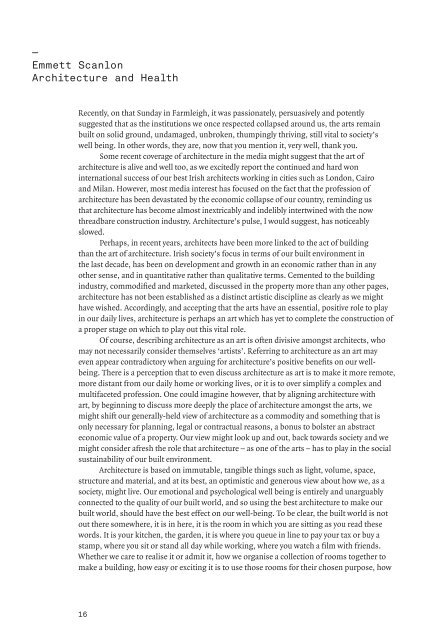Points of View - Arts Council
Points of View - Arts Council
Points of View - Arts Council
Create successful ePaper yourself
Turn your PDF publications into a flip-book with our unique Google optimized e-Paper software.
—<br />
emmett scanlon<br />
Architecture and Health<br />
Recently, on that Sunday in Farmleigh, it was passionately, persuasively and potently<br />
suggested that as the institutions we once respected collapsed around us, the arts remain<br />
built on solid ground, undamaged, unbroken, thumpingly thriving, still vital to society’s<br />
well being. In other words, they are, now that you mention it, very well, thank you.<br />
Some recent coverage <strong>of</strong> architecture in the media might suggest that the art <strong>of</strong><br />
architecture is alive and well too, as we excitedly report the continued and hard won<br />
international success <strong>of</strong> our best Irish architects working in cities such as London, Cairo<br />
and Milan. However, most media interest has focused on the fact that the pr<strong>of</strong>ession <strong>of</strong><br />
architecture has been devastated by the economic collapse <strong>of</strong> our country, reminding us<br />
that architecture has become almost inextricably and indelibly intertwined with the now<br />
threadbare construction industry. Architecture’s pulse, I would suggest, has noticeably<br />
slowed.<br />
Perhaps, in recent years, architects have been more linked to the act <strong>of</strong> building<br />
than the art <strong>of</strong> architecture. Irish society’s focus in terms <strong>of</strong> our built environment in<br />
the last decade, has been on development and growth in an economic rather than in any<br />
other sense, and in quantitative rather than qualitative terms. Cemented to the building<br />
industry, commodified and marketed, discussed in the property more than any other pages,<br />
architecture has not been established as a distinct artistic discipline as clearly as we might<br />
have wished. Accordingly, and accepting that the arts have an essential, positive role to play<br />
in our daily lives, architecture is perhaps an art which has yet to complete the construction <strong>of</strong><br />
a proper stage on which to play out this vital role.<br />
Of course, describing architecture as an art is <strong>of</strong>ten divisive amongst architects, who<br />
may not necessarily consider themselves ‘artists’. Referring to architecture as an art may<br />
even appear contradictory when arguing for architecture’s positive benefits on our wellbeing.<br />
There is a perception that to even discuss architecture as art is to make it more remote,<br />
more distant from our daily home or working lives, or it is to over simplify a complex and<br />
multifaceted pr<strong>of</strong>ession. One could imagine however, that by aligning architecture with<br />
art, by beginning to discuss more deeply the place <strong>of</strong> architecture amongst the arts, we<br />
might shift our generally-held view <strong>of</strong> architecture as a commodity and something that is<br />
only necessary for planning, legal or contractual reasons, a bonus to bolster an abstract<br />
economic value <strong>of</strong> a property. Our view might look up and out, back towards society and we<br />
might consider afresh the role that architecture – as one <strong>of</strong> the arts – has to play in the social<br />
sustainability <strong>of</strong> our built environment.<br />
Architecture is based on immutable, tangible things such as light, volume, space,<br />
structure and material, and at its best, an optimistic and generous view about how we, as a<br />
society, might live. Our emotional and psychological well being is entirely and unarguably<br />
connected to the quality <strong>of</strong> our built world, and so using the best architecture to make our<br />
built world, should have the best effect on our well-being. To be clear, the built world is not<br />
out there somewhere, it is in here, it is the room in which you are sitting as you read these<br />
words. It is your kitchen, the garden, it is where you queue in line to pay your tax or buy a<br />
stamp, where you sit or stand all day while working, where you watch a film with friends.<br />
Whether we care to realise it or admit it, how we organise a collection <strong>of</strong> rooms together to<br />
make a building, how easy or exciting it is to use those rooms for their chosen purpose, how<br />
16


